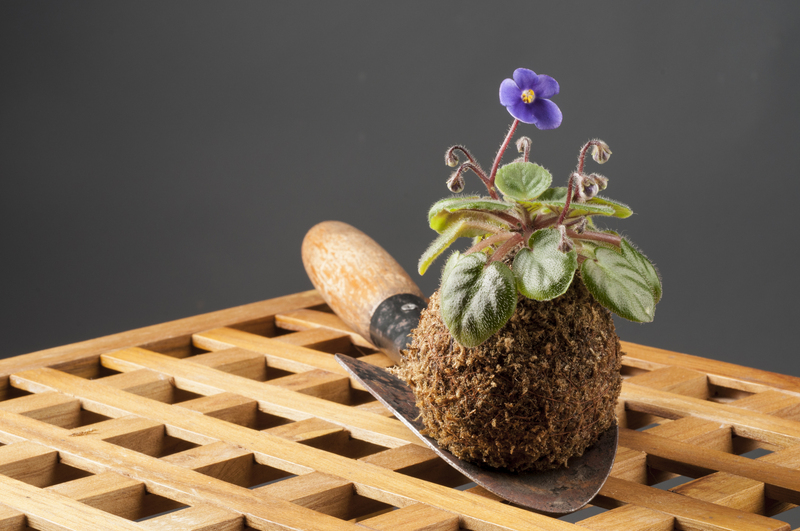Enhance Your Space with Tranquil Zen Garden Creations
Posted on 30/05/2025
Enhance Your Space with Tranquil Zen Garden Creations
If you are seeking a peaceful retreat at home or hoping to infuse your living spaces with calming energies, there's no better way than integrating Tranquil Zen Garden Creations into your environment. Whether you have a sprawling backyard or a cozy balcony, the philosophy and aesthetic of Zen gardens offer serenity, inspiration, and natural beauty. In this comprehensive guide, we will explore the essential elements of Zen-inspired gardens, top design tips, and creative ways to make your space a personal sanctuary.
What is a Zen Garden?
Zen gardens, also known as Japanese rock gardens or "karesansui," are minimalist landscapes that use rocks, gravel, sand, and carefully placed plants to evoke the tranquil essence of nature. Originating in Japan, these gardens have become popular globally for their tranquil atmosphere and ability to foster mindfulness and meditation.
- Symbolism: Every element in a Zen garden represents aspects of nature--stones symbolize mountains, sand or gravel represents water, and moss or small plants denote islands or forests.
- Mindfulness Practice: Raking the gravel or sand into flowing patterns encourages a meditative state, aligning with Zen Buddhist traditions.
- Aesthetic Simplicity: The minimalist design creates an uncluttered, calm space ideal for contemplation.

Benefits of Zen Garden Creations
Incorporating a Zen-inspired garden into your home or office offers a multitude of mental, emotional, and aesthetic benefits:
- Stress Relief: The quiet stillness and simple beauty of a Zen garden provide an oasis of tranquility, lowering anxiety and promoting relaxation.
- Enhanced Focus: Spending time caring for your garden or simply observing its elements encourages mindfulness and improves concentration.
- Creative Expression: Designing your own Zen garden lets you express your artistic vision and connect deeply with nature.
- Visual Appeal: The graceful arrangement of stones, sand, and plants enhances both indoor and outdoor aesthetics significantly.
- Low Maintenance: Zen gardens require minimal upkeep compared to traditional gardens, making them perfect for busy lifestyles.
Essential Elements of Tranquil Zen Garden Creations
Crafting a tranquil Zen garden involves harmonizing several classic elements to create an environment of peace and simplicity. Here are the most vital features to consider for your Zen oasis:
1. Rocks and Stones
Rocks, in different shapes and sizes, form the backbone of any Zen garden design. They symbolize mountains, islands, or animals, depending on their placement and grouping. Use:
- Large boulders for focal points or "mountains."
- Flat pebbles to create visual flow.
- Smaller stones scattered to denote balance and natural randomness.
2. Sand or Gravel
Sand or fine gravel often represents water--streams, rivers, or ocean waves. These materials are raked into patterns to evoke the gentle flow of water. Consider:
- White or light-colored gravel for a clean and calming look.
- Raking spirals, lines, or circles to symbolize waves, currents, or ripples.
3. Greenery and Moss
Although Zen gardens are primarily known for their stony landscapes, adding carefully chosen greenery elevates tranquility:
- Moss patches for a lush, aged effect.
- Dwarf shrubs, bamboo, or evergreens for enduring beauty.
- Minimal blossoms; focus on foliage and form rather than color.
4. Water Features
While classic karesansui are often "dry gardens," integrating a water feature intensifies the tranquil ambiance:
- Small ponds or reflective pools.
- Bubbling bamboo fountains (shishi-odoshi).
- Subtle waterfalls for gentle soundscapes.
5. Decorative Accents and Pathways
Traditional lanterns, stone statues, and pathways convey ancient Japanese aesthetics and guide the flow in your garden:
- Stone lanterns for soft mood lighting.
- Stepping stones placed in a mindful, irregular pattern.
- Bamboo fences or screens for privacy and definition.
Designing Your Tranquil Zen Garden
Choosing the Right Location
Select a quiet corner of your yard, patio, balcony, or even a sunny spot indoors. Prioritize areas that encourage contemplation and aren't overrun by distractions. If possible, combine your Zen garden with a view of nature--existing trees, water bodies, or skies.
Planning the Layout
- Assess Your Space: Measure available area, noting sunlight, shade, and natural features.
- Sketch a Design: Plan the placement of rocks, gravel, plants, and accent pieces.
- Balance Simplicity and Harmony: Avoid clutter; every element should have a purpose.
- Consider Accessibility: Make sure pathways are safe and walking surfaces are stable for easy movement.
Selecting Materials Mindfully
Choose natural materials that blend harmoniously with your surroundings--local rocks, sustainably sourced sand or gravel, native plants, and eco-friendly accents. Prioritize durability, texture, and color consistency for a seamless design.
Creative Ideas for Zen Garden Creations
Zen gardens can take many forms to fit varying spaces and personal preferences. Here are innovative ideas to enhance your space with Tranquil Zen Garden Creations:
Desktop Zen Gardens
Don't have outdoor space? Try a miniature desktop Zen garden! All you need is a shallow tray, fine sand, a few decorative stones, and a tiny rake. Create soothing patterns during work breaks to relieve stress and ignite creativity.
Balcony and Patio Zen Spaces
Small balconies and patios make ideal spots for serene Zen garden sanctuaries. Combine a layer of pebbles or gravel, compact planters with moss, a bench or meditation cushion, and a delicate bamboo fountain for gentle, meditative ambiance.
Meditation Corners
Dedicate an indoor or outdoor nook solely for meditation, framed with smooth river stones, sand, and a backdrop of lush greenery. Add a comfortable mat or zafu (meditation cushion) and a small incense holder to enrich the tranquil atmosphere.
Pathway Zen Gardens
Line a garden path or walkway with Zen-inspired landscaping: stepping stones, moss in between cracks, and miniature stone lanterns. Flank the path with raked gravel beds or pebble mosaics to guide guests through a peaceful journey.
Water Zen Gardens
If you have the space, introduce a still pond or a bubbling rock fountain at the heart of your garden. Surround it with pebbles, boulders, and clumps of bamboo for a mesmerizing, multisensory experience.
Tips for Maintaining Tranquility in Your Zen Garden
A Tranquil Zen Garden is designed for simplicity, but a little regular care will preserve its peaceful beauty. Follow these maintenance strategies:
- Rake frequently: Keep sand or gravel patterns crisp and free of debris; raking itself can become a meditative ritual.
- Weed control: Remove weeds or unwanted plants promptly to maintain a clean, uncluttered scene.
- Prune mindfully: Trim moss and shrubs carefully to sustain shape without over-growing, avoiding harsh lines unless intentionally styled.
- Refresh gravel and sand: Add or replace materials as needed to keep colors bright and textures clean.
- Inspect hardscape elements: Re-position stones, lanterns, or accents if they shift out of place or lose balance.
Infusing Tranquility: Zen Garden Philosophy and Mindfulness
The art and science behind Tranquil Zen Garden Creations goes far beyond aesthetics. Zen gardening is deeply rooted in ancient philosophies that encourage awareness, impermanence, and interconnectedness with nature.
- Simplicity (Kanso): Embrace the beauty of minimalism, removing the non-essential.
- Naturalness (Shizen): Allow the design to reflect organic growth and imperfections found in nature.
- Subtlety (Yugen): Seek deeper meaning in subtle cues and understated forms.
- Asymmetry (Fukinsei): Arrange elements in non-uniform ways, emulating nature's random balance.
Practicing mindfulness while designing, maintaining, or simply sitting in a Zen garden can transform your space into an ever-renewing wellspring of inspiration and peace.
Where to Place Your Zen Garden Creations
- Front Yards: Create a serene entryway that greets guests with calming aesthetics and sets a tranquil tone for your home.
- Backyards: Establish a larger retreat for reading, yoga, or evening relaxation, shielded from hustle and bustle.
- Outdoor Patios or Terraces: Utilize corners with winding gravel and potted evergreens, integrating texture and movement.
- Indoors: Place a tabletop Zen garden in a home office, on a coffee table, or in a meditation room for on-demand serenity.
- Balconies: Incorporate lightweight materials like sand, pebbles, and small lanterns for a space-saving Zen escape.
Choosing Plants and Accessories for Zen Garden Design
The right plants and ornaments can elevate the tranquility of your Zen-inspired garden. Select greenery that thrives in your local climate and requires low maintenance.
Best Plant Choices:
- Bamboo: Symbolizes strength and resilience, perfect for privacy screens and windbreaks.
- Moss: Low-growing, evergreen, and lush, ideal for a mossy, ancient look.
- Japanese Maple: Offers delicate foliage and seasonal color changes.
- Boxwood: Can be pruned into simple shapes to add structure.
- Ferns and Azaleas: Add soft texture and gentle shades of green.
Zen Garden Accessories:
- Stone lanterns: Classic Japanese elements for a timeless glow.
- Bamboo water features: Create soothing sounds and visual movement.
- Pebble mosaics, statues, or driftwood: Add focal points and interest.
Remember, in true Zen fashion, less is often more--choose a few meaningful pieces instead of overcrowding the space.

DIY Zen Garden Creation: Step-by-Step Guide
Ready to begin your own Zen garden journey? Here's a simple process to get you started:
- Pick a location and measure the available space.
- Mark the borders using rocks, wood, or low fencing.
- Clear the area and level the ground--remove any grass, weeds, or debris.
- Lay a weed barrier fabric, then add and level sand or gravel to your desired depth.
- Strategically place large rocks or boulders first, then add small stones and moss patches.
- Rake the sand or gravel into gentle patterns like waves, circles, or lines.
- Introduce accent pieces such as lanterns, statues, or bamboo screens.
- Plant dwarf trees, moss, or shrubs as desired, keeping the composition uncluttered.
Enjoy the process--each action is a step toward mindfulness and personal peace.
Conclusion: Elevate Your Space with Zen Garden Harmony
Creating your own Tranquil Zen Garden--indoors or outdoors--is more than a landscaping project; it's a pathway to tranquility, inspiration, and self-care. With minimalist design, natural elements, and mindful maintenance, any space can be transformed into a haven of calm.
Whether you invest in a sweeping garden retreat or a small desktop display, Zen garden creations will enhance your home's beauty, foster relaxation, and bring lasting serenity into your everyday life. Embark on this creative journey today and watch your surroundings--and your mind--achieve newfound balance and harmony.

